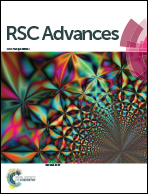A FRET-based ‘off–on’ molecular switch: an effective design strategy for the selective detection of nanomolar Al3+ ions in aqueous media†
Abstract
A new water-soluble rhodamine-based Al3+ ion-selective probe (L1) was synthesised and characterized by physico-chemico and spectroscopic tools. In the presence of a large excess of other competing ions, L1 specifically binds Al3+ ions with a concurrent visually observable change from colorless to pink in electronic spectral behavior, making it possible to detect the presence of Al3+ ions with the naked eye. The addition of Al3+ ions to a solution of L1 in HEPES buffer (1 mM, pH 7.4, 2% EtOH) at 25 °C, results in a decrease in the weak fluorescence intensity at λem = 470 nm, while a new peak (at λem = 588 nm) increases gradually through a fluorescence resonance energy transfer process. This ratiometric enhancement helps to detect Al3+ ions at a very low concentration of 33 nM. The detection limit of L1 for Al3+ ions was estimated to be 6.19 × 10−9 M using the 3σ method. This probe is also useful for imaging Al3+ ions in HeLa cells.


 Please wait while we load your content...
Please wait while we load your content...